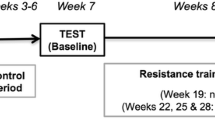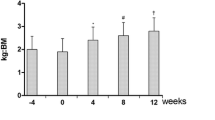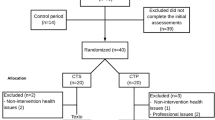Abstract
Cessation of resistance training could result in loss of the gains acquired. Therefore, the aim of the current study was to verify the effect of 1-year of detraining following resistance training on body composition, functional capacity, handgrip strength, localized muscular endurance, and countermovement jump performance (CMJ) in older adults. Fifteen participants (4 women and 11 men; 65.5 ± 4.3 years) completed all the procedures over the experimental period. The participants were followed up during a 9-week resistance training program and after 1-year detraining. Measurements included body composition, handgrip strength, localized muscular endurance, stair ascent and descent, timed up-and-go, and CMJ. The resistance training resulted in improvements in skeletal muscle mass, stair ascent and descent, handgrip strength, localized muscular endurance, and CMJ variables. After the detraining period, significant reductions were observed in skeletal muscle mass (Δ = − 0.92 ± 0.58 kg) and CMJ height, velocity, and impulse (Δ = − 3.03 ± 1.83 cm, − 0.063 ± 0.042 m/s, − 6.34 ± 8.49 N·s, respectively) compared to the post-training period, returning to the baseline values. Conversely, stair ascent and descent, handgrip strength, and localized muscular endurance did not differ after the detraining period (p > 0.05). Retention of functional capacity, localized muscular endurance, and handgrip strength improvements were observed. However, skeletal muscle mass and CMJ variables decreased after the detraining period.
Similar content being viewed by others
References
da Orssatto LBR, Wiest MJ, Diefenthaeler F (2018) Neural and musculotendinous mechanisms underpinning age-related force reductions. Mech Ageing Dev 175:17–23. https://doi.org/10.1016/j.mad.2018.06.005
Byrne C, Faure C, Keene DJ, Lamb SE (2016) Ageing, muscle power and physical function: a systematic review and implications for pragmatic training interventions. Sport Med. https://doi.org/10.1007/s40279-016-0489-x
Syddall H, Cooper C, Martin F et al (2003) Is grip strength a useful single marker of frailty? Age Ageing 32:650–656. https://doi.org/10.1093/ageing/afg111
Sasaki H, Kasagi F, Yamada M, Fujita S (2007) Grip strength predicts cause-specific mortality in middle-aged and elderly persons. Am J Med 120:337–342. https://doi.org/10.1016/j.amjmed.2006.04.018
Legrand D, Vaes B, Matheï C et al (2014) Muscle strength and physical performance as predictors of mortality, hospitalization, and disability in the oldest old. J Am Geriatr Soc 62:1030–1038. https://doi.org/10.1111/jgs.12840
Kelley GA, Kelley KS (2017) Is sarcopenia associated with an increased risk of all-cause mortality and functional disability? Exp Gerontol 96:100–103. https://doi.org/10.1016/j.exger.2017.06.008
Hayashida I, Tanimoto Y, Takahashi Y et al (2014) Correlation between muscle strength and muscle mass, and their association with walking speed, in community-dwelling elderly Japanese individuals. PLoS ONE 9:1–6. https://doi.org/10.1371/journal.pone.0111810
Pratesi A, Tarantini F, Di Bari M (2013) Skeletal muscle: an endocrine organ. Clin Cases Miner Bone Metab 10:11–14. https://doi.org/10.11138/ccmbm/2013.10.1.011
Larsen AH, Sørensen H, Puggaard L, Aagaard P (2009) Biomechanical determinants of maximal stair climbing capacity in healthy elderly women. Scand J Med Sci Sport 19:678–686. https://doi.org/10.1111/j.1600-0838.2008.00845.x
Izquierdo M, Aguado X, Gonzalez R et al (1999) Maximal and explosive force production capacity and balance performance in men of different ages. Eur J Appl Physiol Occup Physiol 79:260–267. https://doi.org/10.1007/s004210050504
Borde R, Hortobágyi T, Granacher U (2015) Dose–response relationships of resistance training in healthy old adults: a systematic review and meta-analysis. Sport Med 45:1693–1720. https://doi.org/10.1007/s40279-015-0385-9
da Orssatto LBR, Cadore EL, Andersen LL, Diefenthaeler F (2018) Why fast velocity resistance training should be prioritized for elderly people. Strength Cond J. https://doi.org/10.1519/SSC.0000000000000390
Peterson MD, Sen A, Gordon PM (2011) Influence of resistance exercise on lean body mass in aging adults: a meta-analysis. Med Sci Sport Exerc 43:249–258. https://doi.org/10.1249/MSS.0b013e3181eb6265.Influence
de Guizelini PC, Aguiar RA, Denadai BS et al (2018) Effect of resistance training on muscle strength and rate of force development in healthy older adults: a systematic review and meta-analysis. Exp Gerontol 102:51–58. https://doi.org/10.1016/j.exger.2017.11.020
da Orssatto LBR, de la Freitas CR, Shield AJ et al (2019) Effects of resistance training concentric velocity on older adults’ functional capacity: a systematic review and meta-analysis of randomised trials. Exp Gerontol 127:110731. https://doi.org/10.1016/j.exger.2019.110731
Orssatto LBR, de Bezerra ES, Shield AJ, Trajano GS (2020) Is power training effective to produce muscle hypertrophy in older adults? A systematic review and meta-analysis. Appl Physiol Nutr Metab. https://doi.org/10.1139/apnm-2020-0021
Ratamess A, Alvar BA, Evetoch TK et al (2009) American College of Sports Medicine Position Stand: progression models in resistance training for healthy adults. Med Sci Sports Exerc 41:687–708. https://doi.org/10.1249/MSS.0b013e3181915670
Fragala MS, Cadore EL, Dorgo S et al (2019) Resistance training for older adults: position statement from the national strength and conditioning association. J Strength Cond Res 33:2019–2052. https://doi.org/10.1519/JSC.0000000000003230
Sakugawa RL, Moura BM, da Orssatto LBR et al (2019) Effects of resistance training, detraining, and retraining on strength and functional capacity in elderly. Aging Clin Exp Res 31:31–39. https://doi.org/10.1007/s40520-018-0970-5
Henwood TR, Taaffe DR (2008) Detraining and retraining in older adults following long-term muscle power or muscle strength specific training. J Gerontol Ser A Biol Sci Med Sci 63:751–758. https://doi.org/10.1093/gerona/63.7.751
Pereira A, Izquierdo M, Silva AJ et al (2012) Muscle performance and functional capacity retention in older women after high-speed power training cessation. Exp Gerontol 47:620–624. https://doi.org/10.1016/j.exger.2012.05.014
Zech A, Drey M, Freiberger E et al (2012) Residual effects of muscle strength and muscle power training and detraining on physical function in community-dwelling prefrail older adults: a randomized controlled trial. BMC Geriatr 12:68. https://doi.org/10.1186/1471-2318-12-68
Hasselmann V, Oesch P, Fernandez-Luque L, Bachmann S (2015) Are exergames promoting mobility an attractive alternative to conventional self-regulated exercises for elderly people in a rehabilitation setting? Study protocol of a randomized controlled trial. BMC Geriatr 15:108. https://doi.org/10.1186/s12877-015-0106-0
Phillips EM, Schneider JC, Mercer GR (2004) Motivating elders to initiate and maintain exercise. Arch Phys Med Rehabil 85:52–57. https://doi.org/10.1016/j.apmr.2004.03.012
de Bezerra ES, Diefenthaeler F, Sakugawa RL et al (2019) Effects of different strength training volumes and subsequent detraining on strength performance in aging adults. J Bodyw Mov Ther 23:466–472. https://doi.org/10.1016/j.jbmt.2019.01.010
de Bezerra ES, da Orssatto LBR, de Moura BM et al (2018) Mixed session periodization as a new approach for strength, power, functional performance, and body composition enhancement in aging adults. J Strength Cond Res 32:2795–2806. https://doi.org/10.1519/JSC.0000000000002752
Orange ST, Marshall P, Madden LA, Vince RV (2019) Short-term training and detraining effects of supervised vs. unsupervised resistance exercise in aging adults. J Strength Cond Res 33:2733–2742. https://doi.org/10.1519/JSC.0000000000002536
Correa CS, Cunha G, Marques N et al (2016) Effects of strength training, detraining and retraining in muscle strength, hypertrophy and functional tasks in older female adults. Clin Physiol Funct Imaging 36:306–310. https://doi.org/10.1111/cpf.12230
Virtuoso Junior JS, Tribess S, Paulo TRSD, Martins CA, Romo-Perez V (2012) Physical activity as an indicator of predictive functional disability in elderly. rev lat-am de enferm 20(2):259–265. https://doi.org/10.1590/S0104-11692012000200007
Kim J, Wang Z, Heymsfield SB et al (2002) Total-body skeletal muscle mass: estimation by a new dual-energy X-ray absorptiometry method. Am J Clin Nutr 76:378–383
Da Silva ME et al (2018) Reducing measurement errors during functional capacity tests in elders. Aging Clin Exp Res 30:595–603
Sousa-Santos AR, Amaral TF (2017) Differences in handgrip strength protocols to identify sarcopenia and frailty—a systematic review. BMC Geriatr. https://doi.org/10.1186/s12877-017-0625-y
Rikli RE, Jones CJ (2013) Development and validation of criterion-referenced clinically relevant fitness standards for maintaining physical independence in later years. Gerontologist 53:255–267. https://doi.org/10.1093/geront/gns071
Ache-Dias J, Dal Pupo J, Gheller RG et al (2016) Power output prediction from jump height and body mass does not appropriately categorize or rank athletes. J Strength Cond Res 30:818–824. https://doi.org/10.1519/jsc.0000000000001150
Kons RL, Ache-Dias J, Detanico D et al (2017) Is vertical jump height an indicator of athletes’power output in different sport modalities? J Strength Cond Res. https://doi.org/10.1098/rsif.2012.0028
https://www.iscd.org/official-positions/2019-iscd-official-positions-adult/
Steenhuis RE, Bryden MP, Schwartz M, Lawson S (1990) Reliability of hand preference items and factors. J Clin Exp Neuropsychol 12:921–930. https://doi.org/10.1080/01688639008401031
de Bezerra ES, da Orssatto LBR, de Moura BM et al (2018) Mixed session periodization as a new approach for strength, power, functional performance, and body composition enhancement in aging adults. J Strength Cond Res. https://doi.org/10.1519/JSC.0000000000002752
Hopkins WG, Marshall SW, Batterham AM, Hanin J (2009) Progressive statistics for studies in sports medicine and exercise science. Med Sci Sports Exerc 41:3–12. https://doi.org/10.1249/MSS.0b013e31818cb278
Santos L, Ribeiro AS, Schoenfeld BJ et al (2017) The improvement in walking speed induced by resistance training is associated with increased muscular strength but not skeletal muscle mass in older women. Eur J Sport Sci 17:488–494. https://doi.org/10.1080/17461391.2016.1273394
Lixandrão ME, Damas F, Chacon-Mikahil MPT et al (2016) Time course of resistance training-induced muscle hypertrophy in the elderly. J Strength Cond Res 30:159–163. https://doi.org/10.1519/JSC.0000000000001019
Larsson L, Degens H, Li M et al (2019) Sarcopenia: aging-related loss of muscle mass and function. Physiol Rev 99:427–511. https://doi.org/10.1152/physrev.00061.2017
Han DS, Chang KV, Li CM et al (2016) Skeletal muscle mass adjusted by height correlated better with muscular functions than that adjusted by body weight in defining sarcopenia. Sci Rep 6:1–8. https://doi.org/10.1038/srep19457
Anker SD, Morley JE, von Haehling S (2016) Welcome to the ICD-10 code for sarcopenia. J Cachexia Sarcopenia Muscle 7:512–514. https://doi.org/10.1002/jcsm.12147
Cruz-Jentoft AJ, Baeyens JP, Bauer JM et al (2010) Sarcopenia: European consensus on definition and diagnosis. Age Ageing 39:412–423. https://doi.org/10.1093/ageing/afq034
Cruz-Jentoft AJ, Bahat G, Bauer J et al (2019) Sarcopenia: revised European consensus on definition and diagnosis. Age Ageing. https://doi.org/10.1093/ageing/afy169
Lemmer JT, Hurlbut DE, Martel GF et al (2000) Age and gender responses to strength training and detraining. Med Sci Sports Exerc 32:1505–1512. https://doi.org/10.1097/00005768-200008000-00021
Taaffe DR, Marcus R (1997) Dynamic muscle strength alterations to detraining and retraining in elderly men. Clin Physiol 17:311–324. https://doi.org/10.1111/j.1365-2281.1997.tb00010.x
Narici MV, Roi GS, Landoni L et al (1989) Changes in force, cross-sectional area and neural activation during strength training and detraining of the human quadriceps. Eur J Appl Physiol Occup Physiol 59:310–319. https://doi.org/10.1007/BF02388334
Andersen LL, Andersen JL, Magnusson SP, Aagaard P (2005) Neuromuscular adaptations to detraining following resistance training in previously untrained subjects. Eur J Appl Physiol 93:511–518. https://doi.org/10.1007/s00421-004-1297-9
de Moura BM, Sakugawa RL, da Orssatto LBR et al (2018) Functional capacity improves in-line with neuromuscular performance after 12 weeks of non-linear periodization strength training in the elderly. Aging Clin Exp Res 30:959–968. https://doi.org/10.1007/s40520-017-0873-x
da Silva ME, da Orssatto LBR, de Bezerra ES et al (2017) Reducing measurement errors during functional capacity tests in elders. Aging Clin Exp Res 30:595–603. https://doi.org/10.1007/s40520-017-0820-x
Ramirez-campillo R, Cristi-montero C, Ramirez-campillo R, Diaz D (2016) Effects of different doses of high-speed resistance training on physical performance and quality of life in older women: a randomized controlled trial. Clin Interv Aging 11:1–8
Ramirez-Campillo R, Castillo A, de la Fuente CI et al (2014) High-speed resistance training is more effective than low-speed resistance training to increase functional capacity and muscle performance in older women. Exp Gerontol 58:51–57. https://doi.org/10.1016/j.exger.2014.07.001
Barbalho MDSM, Gentil P, Fisher J et al (2017) There are no no-responders to low or high resistance training volumes among older women. Exp Gerontol 1:18–26. https://doi.org/10.1016/j.exger.2017.09.003
Ramírez-Campillo R, Castillo A, de la Fuente CI et al (2014) High-speed resistance training is more effective than low-speed resistance training to increase functional capacity and muscle performance in older women. Exp Gerontol 58:51–57. https://doi.org/10.1016/j.exger.2014.07.001
Correa C, LaRoche D, Cadore E et al (2012) 3 different types of strength training in older women. Int J Sports Med. https://doi.org/10.1055/s-0032-1312648
Steib S, Schoene D, Pfeifer K (2010) Dose–response relationship of resistance training in older adults. Med Sci Sport Exerc 42:902–914. https://doi.org/10.1249/MSS.0b013e3181c34465
Murlasits Z, Reed J, Wells K (2012) Effect of resistance training frequency on physiological adaptations in older adults. J Exerc Sci Fit 10:28–32. https://doi.org/10.1016/j.jesf.2012.04.006
Orssatto LBR, Moura BM, Bezerra ES et al (2018) Influence of strength training intensity on subsequent recovery in elderly. Exp Gerontol 106:232–239. https://doi.org/10.1016/j.exger.2018.03.011
Conlon JA, Newton RU, Tufano JJ et al (2017) The efficacy of periodised resistance training on neuromuscular adaptation in older adults. Eur J Appl Physiol. https://doi.org/10.1007/s00421-017-3605-1
Ciaccioni S, Capranica L, Forte R et al (2019) Effects of a judo training on functional fitness, anthropometric, and psychological variables in old novice practitioners. J Aging Phys Act 27:831–842. https://doi.org/10.1123/japa.2018-0341
Author information
Authors and Affiliations
Corresponding author
Ethics declarations
Conflict of interest
On behalf of all authors, the corresponding author states that there is no conflict of interest.
Ethical approval
All procedures were approved by the University Ethics Committee (N.1.657.414) and followed the Declaration of Helsinki (version 2008).
Informed consent
Before the beginning of the study, participants were informed of the purpose, procedures, benefits, and risks of participation and signed the written informed consent.
Additional information
Publisher's Note
Springer Nature remains neutral with regard to jurisdictional claims in published maps and institutional affiliations.
Rights and permissions
About this article
Cite this article
Bezerra, E.d., Orssatto, L.B.R., Oliveira, S.N. et al. One-year cessation following resistance training differently affects neuromuscular, body composition, and functional capacity in older adults. Sport Sci Health 17, 347–355 (2021). https://doi.org/10.1007/s11332-020-00695-7
Received:
Accepted:
Published:
Issue Date:
DOI: https://doi.org/10.1007/s11332-020-00695-7




